How to Hand Wash Clothes: Easy Step-by-Step Guide
This article is dedicated to providing useful knowledge on garment care. Specifically, washing clothes by hand. Maybe you have some items made from special materials. Or, you own clothing with intricate details that a washing machine could damage. You’ve come to the right place. This article will help you understand the proper techniques for hand washing.
Hand washing (manually cleaning clothes with water and detergent, as opposed to using a washing machine) is a useful skill. It can extend the lifespan of your clothes, and save water in the long run. Here, you’ll learn how to take care of your delicate fabrics, ensuring proper garment care. This will cover everything, from the initial steps of laundry preparation to the final cleaning and clothing maintenance procedures.
1. Why choose hand washing?
Hand washing might seem like more work compared to using a machine. However, it offers some distinct advantages, especially regarding delicate fabrics and overall fabric preservation. Choosing a gentler cleaning approach helps protect your valued garments. Let’s examine some of the benefits
1.1. Gentler on fabrics
Machine washing, even on a delicate cycle, can be harsh. Hand washing, however, allows you to control the pressure and movement. This gentle care minimizes the risk of stretching, snagging, or damaging fibers, which is critical for delicate fabrics and fabric preservation.
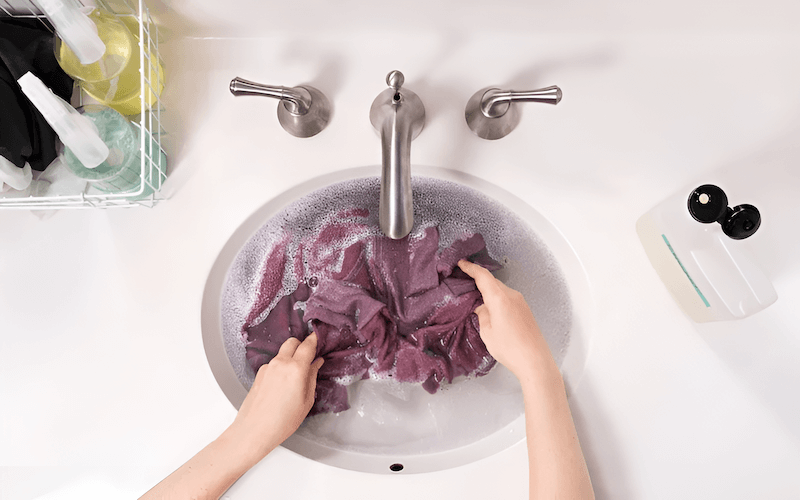
1.2 Extends garment lifespan
By reducing the mechanical stress and agitation clothes experience in a washing machine, hand washing significantly reduces wear and tear. This contributes directly to clothing maintenance and garment preservation. Clothes that are hand-washed often retain their shape, color, and overall quality for a much longer time.
1.3 Saves water and energy
Hand washing typically uses significantly less water than even the most efficient washing machines. A full machine cycle requires a lot of water to fill the drum. Hand washing a few items only needs a small basin. This lower water usage, coupled with the elimination of electricity needed to power a machine, translates to lower energy consumption. These are eco-friendly laundry practices.
1.4 Ideal for delicate items
Certain garments are simply too fragile for machine washing. Hand washing is the preferred method for items like silk, wool, lace, and embellished garments. These delicate fabrics require the gentle touch that only hand washing can provide.
1.5 Better stain removal control
Handwashing allows for direct spot treatment. With careful application, it can lift the foreign substance. You can focus on specific areas requiring extra attention during stain removal. This pre-treatment capability lets you address stains immediately and effectively, increasing the chances of complete removal before they set.

2. Preparing for hand washing
Before you even turn on the faucet, taking some preparatory steps will ensure a successful hand-washing experience.
2.1 Reading care labels
Care label instructions are your first and most important guide. Locate the care label, usually sewn inside the garment. Look for the hand-wash symbol (a tub of water with a hand in it). This symbol indicates that hand washing is recommended or required. The label also gives you important information on fabric type, and details like recommended water temperature.
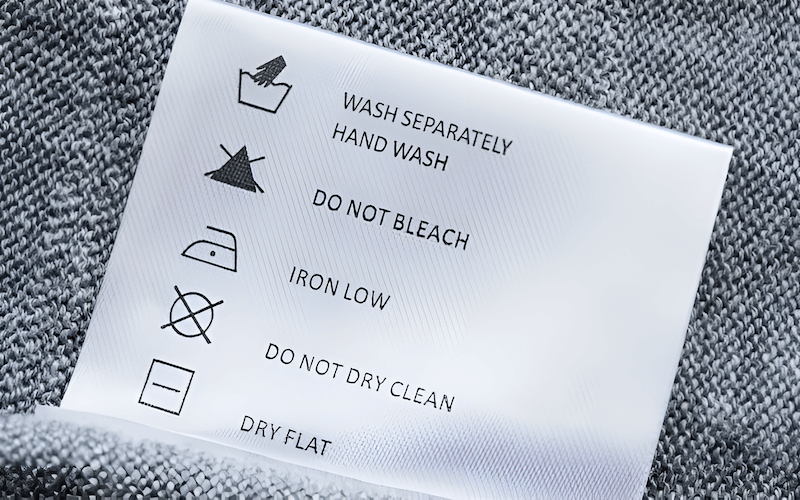
2.2. Gathering supplies
Having everything you need within reach will make the process smoother. Here’s a list of what you need:
- Detergent (specifically formulated for hand washing or delicate fabrics)
- A clean washing basin/sink
- Clean water
- Space to soak your garments
- A place to rinse
- A place for washed garments to dry
- Clean towels
- A drying rack (optional, but highly recommended)
2.3 Choosing the right detergent:
Selecting the right detergent is important for protecting your clothes. Avoid harsh detergents with strong chemicals or bleach. Opt for a gentle detergent specifically designed for hand washing or delicates. Look for formulas that are pH-neutral. Woolite is a popular brand, but any pH-neutral detergent or even a pH-neutral shampoo can work in a pinch, particularly for protein-based fibers like wool or silk.
2.4 Testing for colorfastness
Before washing the entire garment, it’s wise to test for colorfastness, especially with new or brightly colored items. This colorfastness testing helps prevent color bleeding during the washing process.
- Find a hidden area of the garment, like an inner seam.
- Dampen a small section of the fabric with water.
- Gently blot the dampened area with a white cloth or paper towel.
- If any color transfers to the cloth, the garment is not colorfast. You should wash it separately or consider professional cleaning.
2.5 Sorting clothes
Just like with machine washing, sorting clothes before hand washing is important. Separate clothes by color (lights, darks, and whites) and by fabric type. Delicate items like silk or lace should be washed separately from heavier fabrics like denim or cotton.
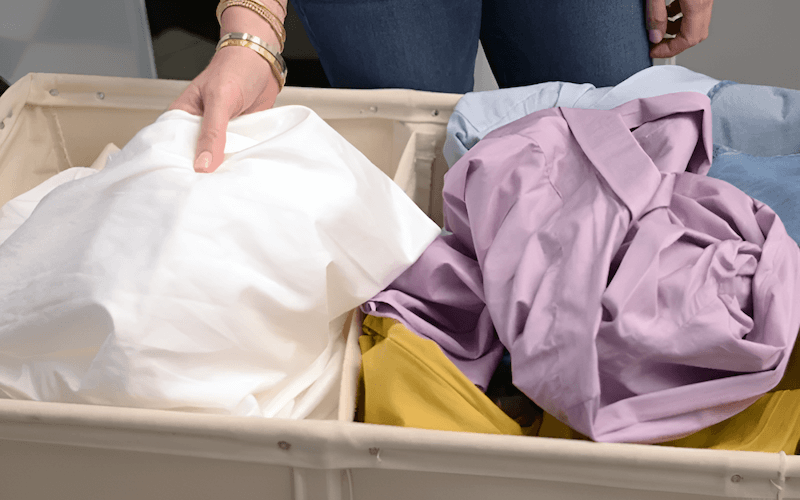
3. Step-by-step hand washing guide
Now that you’ve prepared your materials and garments, it’s time to start the hand-washing process.
3.1 Pre-treating stains:
- Identify the Stain: Before you begin, take a close look at your garment and locate any stains.
- Apply Stain Remover: Apply a small amount of stain pretreatment solution directly to the stained area. There are many options, like Shout, or Grandma’s Secret Spot Remover.
- Gentle Application: Use your fingertips or a soft-bristled brush (like an old toothbrush) to gently work the stain remover into the fabric. Avoid vigorous rubbing, which can damage the fibers.
- Waiting Time: Allow the stain remover to sit for the time recommended on the product label, usually 5-15 minutes.
3.2 Filling the basin/sink:
Clean the Basin: Ensure your washing basin/sink is clean and free of any residue.
Choose the Right Water Temperature: The correct water temperature depends on the fabric type.
- Cold water (around 60-80°F/15-27°C): Best for delicate fabrics like silk, lace, and brightly colored items prone to fading.
- Lukewarm water (around 80-100°F/27-38°C): Suitable for most fabrics, including synthetics, blends, and lightly soiled items.
- Warm water (around 100-120°F/38-49°C): Generally not recommended for hand washing, as it can cause shrinkage or damage to delicate fibers. Use only if the care label specifically allows it.
Fill with water.

3.3 Adding detergent:
Measure Carefully: Follow the instructions on your hand-wash detergent label for the correct dosage. Using too much detergent can make rinsing difficult, while using too little may not clean effectively. A general guideline is about one teaspoon per gallon of water, but this can vary.
Dissolve Completely: Add the measured detergent to the water in the basin/sink and agitate the water with your hand to ensure the detergent is fully dissolved before adding any clothes.
3.4 Submerging and soaking:
Submerge Gently: Carefully place your garment into the basin, ensuring it’s fully submerged in the soapy water.
Gentle Agitation: Use your hands to gently agitate the fabric. Avoid harsh scrubbing, twisting, or wringing. The goal is to allow the soapy water to penetrate the fibers and loosen dirt and grime. Imagine gently swishing the garment back and forth.
Soaking Process: Allow the garment to soak for an appropriate amount of time. The soaking process duration depends on the fabric type and how soiled the item is.
- Delicates (silk, lace): 5-15 minutes
- Most other fabrics: 15-30 minutes
- Heavily soiled items: Up to 30 minutes (check the care label)
3.5 Rinsing thoroughly
Drain the Soapy Water: Drain the soapy water from the basin/sink.
Multiple Rinses: Fill the basin with clean, cool water. Gently agitate the garment in the clean water to rinse away any remaining detergent. Repeat this rinsing process several times, draining and refilling the basin with fresh water, until the water runs clear and no more suds are visible.
3.6 Removing excess water
Gentle Squeezing: Gently squeeze the excess water from the garment, supporting its weight with both hands. Do not twist or wring, as this can stretch and damage the fibers.
Alternative Method: Basin Press: You can also press the garment against the side of the basin/sink to remove excess water.
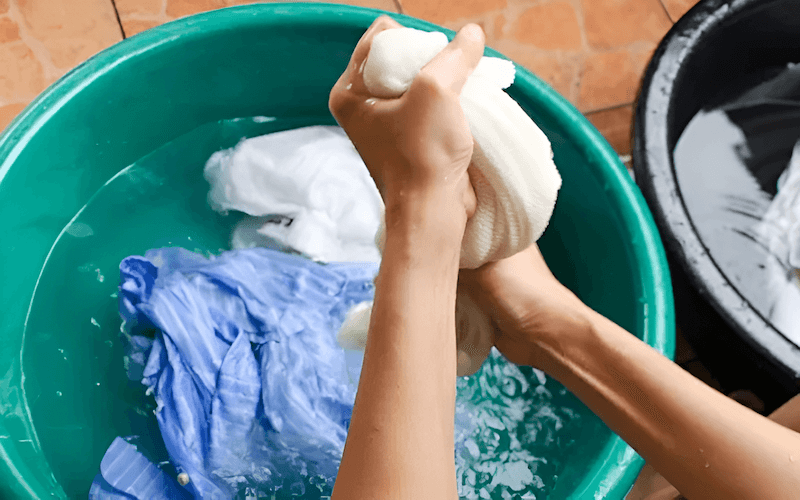
4. Drying hand-washed clothes
Proper drying is just as important as proper washing. Incorrect drying methods can undo all your careful hand-washing efforts.
4.1 Towel blotting
- Lay Flat: Spread a clean, absorbent towel (preferably white or light-colored to avoid dye transfer) on a flat surface.
- Position the Garment: Carefully lay the freshly rinsed garment flat on top of the towel.
- Roll and Press: Gently roll up the towel with the garment inside, like a jelly roll. Apply gentle pressure as you roll to absorb excess water. Avoid twisting or wringing.
- Repeat if Necessary: If the towel becomes saturated, unroll it and repeat the process with a fresh, dry towel.
4.2 Laying flat to dry
- Ideal for: This drying method (flat) is particularly important for sweaters, knits, and other items prone to stretching or losing their shape.
- Prepare a Surface: Choose a clean, flat surface, ideally a mesh drying rack that allows for air circulation. If using a solid surface, cover it with a clean, dry towel.
- Shape the Garment: Gently reshape the garment to its original form, smoothing out any wrinkles or creases. Lay flat to dry. Ensure the garment is evenly spread out and not bunched up.
- Prevent Stretching: Avoid any pulling that may distort the shape.

4.3 Hang drying
- Suitable Garments: This drying method (hang) is appropriate for some woven fabrics, like shirts, blouses, and dresses, that are less prone to stretching. Check the care label to confirm.
- Use Proper Hangers: Use padded or shaped hangers to prevent hanger marks or stretching at the shoulders. Avoid wire hangers, which can rust or leave impressions.
- Proper Positioning: Button or zip up the garment and hang it evenly on the hanger. Smooth out any wrinkles.
4.4 Avoiding direct sunlight and heat
- Fading and Damage: Direct sunlight and heat sources (like radiators or direct sunlight) can cause fading, shrinkage, and damage to the fibers of your clothes. These are not ideal alternative drying methods.
- Indirect Light and Air Circulation: Choose a well-ventilated area with indirect light for drying.
4.5 Using a drying rack
- Benefits: A drying rack provides excellent air circulation, which speeds up the drying process and helps prevent mildew or musty odors. Mesh drying racks are particularly good for sweaters and other items that need to be laid flat.
- Proper Placement: Place the drying rack in a well-ventilated area, away from direct sunlight and heat.

5. Hand washing specific garment types
While the general hand-washing steps apply to many items, certain garment types require specific considerations.
5.1 Delicates (bras, lingerie, silk blouses)
- Focus: The primary concern with delicate fabrics (silk, lace) is preserving their shape, delicate details, and preventing damage.
- Gentle Handling: Handle these items with extreme care. Avoid any harsh rubbing, scrubbing, or twisting.
Use cool or lukewarm water. - Use a gentle detergent formulated for delicates.
- Soak for a shorter time (5-15 minutes).
- Rinse thoroughly but gently.
- Support the garment’s weight when removing excess water.
- Lay flat to dry or hang carefully, avoiding stretching.
5.2 Sweaters (wool, cashmere)
- Focus: The main goal when washing delicate wool sweaters is to prevent shrinking and stretching.
- Water Temperature: Use cool or lukewarm water. Hot water can cause wool and cashmere to shrink.
- Use a gentle detergent, Woolite, is one recommendation.
- Gentle Agitation: Avoid any vigorous rubbing or agitation, which can cause felting (matting of the fibers).
- Soaking: Soak for a moderate amount of time (10-30 minutes).
- Rinsing: Rinse thoroughly with cool water.
- Removing Excess Water: Support the sweater’s weight and gently squeeze out excess water. Avoid wringing.
- Drying: Lay flat to dry on a clean, dry towel or mesh drying rack, reshaping the sweater to its original form.
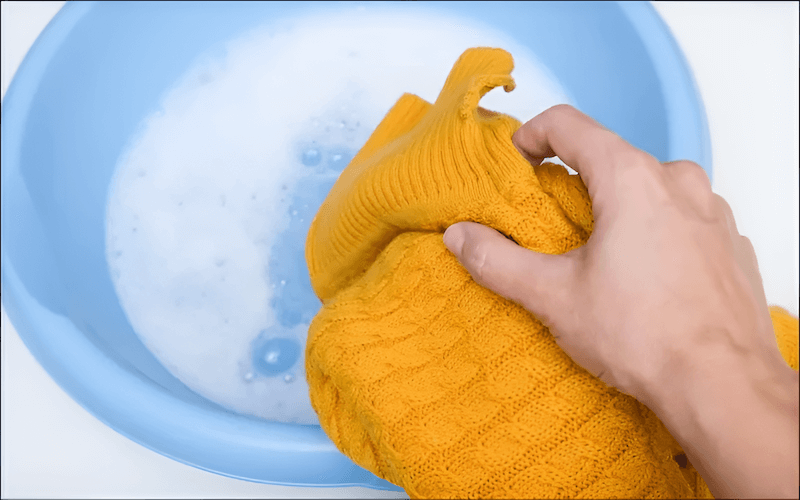
5.3 Tights and hosiery
- Focus is to prevent snags.
- Use lukewarm water and a mild detergent.
- Turn inside out.
- Gently scrub prone areas (feet).
- Soak for a short time (5-10 minutes).
- Rinse thoroughly with cool water.
- Squeeze out excess water gently.
- Lay flat to dry or hang carefully to avoid snags.
5.4 Hats (baseball caps, avoiding cardboard bills)
- Pre-treat Stains: If the hat has visible stains, pre-treat them with a stain remover.
- Avoid Submerging Cardboard Bills: If the hat has a cardboard bill, do not submerge it in water. Spot-clean the bill with a damp cloth and a mild detergent solution.
- Washing Fabric Hats: For hats without cardboard bills, you can follow the general hand-washing steps, using cool water and a mild detergent.
- Rinsing: Rinse thoroughly.
- Drying: Air-dry the hat, reshaping it as needed. You can stuff the crown with a clean towel to help it maintain its shape.
5.5 Baby clothes.
- Use gentle detergents.
- Focus on sanitation
- Use a gentle detergent formulated for baby clothes or a mild, fragrance-free detergent.
- Pre-treat any stains.
- Wash in warm or lukewarm water (check the care label).
- Rinse thoroughly to remove all traces of detergent.
- Sanitize if necessary (see Related Questions section).
- Air-dry or machine-dry on a low setting (check the care label).
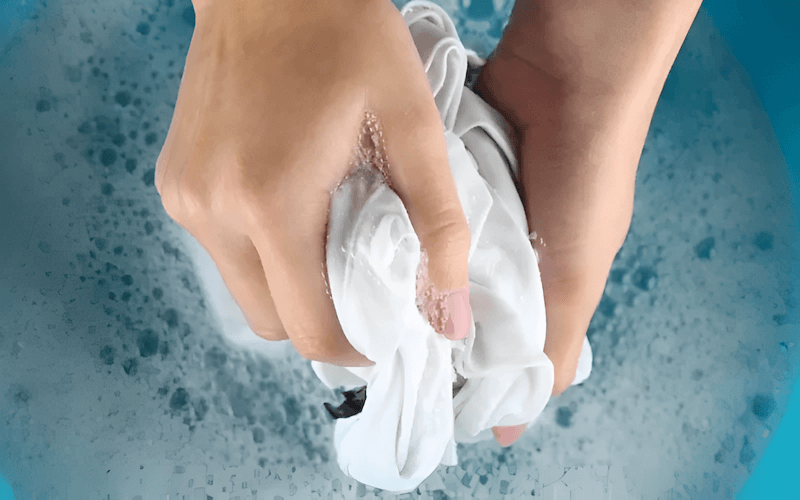
5.6 Swimwear
- Focus on removing chemicals, preserving elasticity
- Fabric softener (optional)
- Rinse Immediately: Rinse swimwear immediately after use to remove chlorine, salt water, sunscreen, and body oils.
- Hand-wash with cool water and a mild detergent.
Soak for a short time (15-30 minutes). - Rinse thoroughly.
Gently squeeze out excess water. - Lay flat to dry or hang, avoiding direct sunlight.
6. Common hand washing mistakes and how to avoid them
Knowing what not to do is just as important as knowing what to do when hand washing clothes.
6.1 Using too much detergent
Consequences: Using excessive detergent can make it very difficult to rinse out completely. This can leave a residue on the fabric, making it feel stiff, attracting dirt, and potentially irritating the skin.
How to Avoid: Carefully follow the detergent manufacturer’s instructions. Remember, less is often more when hand washing.
6.2 Wringing or twisting clothes
Consequences: Wringing or twisting wet clothes, especially delicates, can stretch, distort, and damage the fibers, leading to misshapen garments.
How to Avoid: Gentle care is crucial. Always gently squeeze out excess water, supporting the garment’s weight. Use the towel blotting method described earlier.
6.3 Using hot water on delicate fabrics
Consequences: Hot water temperature can cause delicate fabrics like silk, wool, lace, and some synthetics to shrink, fade, or become damaged.
How to Avoid: Always use cool or lukewarm water for delicate fabrics. Refer to the care label for specific temperature recommendations.
6.4 Not rinsing thoroughly
Consequences: Failing to rinse out all the detergent can leave a residue, leading to stiffness, skin irritation, and attracting dirt.
How to Avoid: Rinse multiple times with clean water until the water runs completely clear and no suds are visible.
6.5 Drying in direct sunlight
Consequences: Direct sunlight can cause colors to fade, especially on darker fabrics, and can also damage delicate fibers.
How to avoid: Dry in a well ventilated area, but out of direct sunlight.
7. Related questions
This section addresses some frequently asked questions about hand washing.
7.1 Can I hand wash clothes labeled “dry clean only”?
Explanation of Risks: “Dry clean only” labels are often placed on garments made from fabrics that are sensitive to water or that have delicate construction. Hand washing these items carries risks, including:
- Shrinkage: The fabric may shrink, altering the garment’s fit.
- Distortion: The garment’s shape may become distorted.
- Color Loss or Bleeding: The colors may fade or bleed.
- Damage to Lining or Trim: The lining or any embellishments may be damaged.
Recommendation: It’s generally best to follow the “dry clean only” recommendation. However, if you’re willing to take a risk, you can test a small, hidden area of the garment first (as described in the “Testing for Colorfastness” section). If the test is successful, you can try hand washing, but proceed with extreme caution and be aware that you’re doing so at your own risk.
7.2 Is hand-washing clothes as sanitary as using a washing machine?
Explanation of Differences: Washing machines, especially on hot water settings or with sanitizing cycles, can reach temperatures that kill most bacteria and germs. Hand washing, typically done in cooler water, may not achieve the same level of sanitation.
Recommendation: For everyday clothes, hand washing is generally sufficient for cleaning. However, for items that require thorough sanitization, such as baby clothes, cloth diapers, or items soiled with bodily fluids, a washing machine with a hot water or sanitizing cycle is recommended. You can also consider adding a laundry sanitizer to your hand-washing routine if needed.
7.3 How do I hand wash large items like blankets or coats?
- Use a Bathtub: For very large items like blankets or coats, a bathtub is usually the best option. Make sure the bathtub is thoroughly clean.
- Follow the Same Principles: Follow the same general hand-washing steps: pre-treat stains, use the appropriate water temperature, add detergent, submerge and gently agitate, soak, and rinse thoroughly.
- Multiple Rinses: You may need to rinse multiple times, draining and refilling the tub with clean water, to remove all the detergent.
- Removing Excess Water: Removing excess water from a large, heavy item can be challenging. You may need to press the item against the sides of the tub and gently squeeze out as much water as possible. You can also use multiple towels to blot out excess water.
- Drying: Drying large items requires space and time. You may need to hang the item over a shower rod or clothesline, or lay it flat on a clean, dry surface, flipping it periodically. Ensure good air circulation to prevent mildew.
Read more:
Hand washing clothes, while it may seem time-consuming initially, offers numerous benefits. It’s a gentler approach to garment care, preserving the life and beauty of your clothes. It’s particularly crucial for delicate fabrics and items with special embellishments.
By following the steps outlined in this guide, you can confidently hand wash a wide range of garments, ensuring they stay in excellent condition for years to come. You can also save signficant amounts of water, when compared to machine washing.
Visit our website https://mypacklove.com/ to explore our product options and request a quote. Contact us today to discuss your specific needs! Let us help you enhance your clothing care and branding efforts.






















